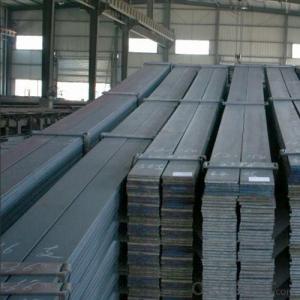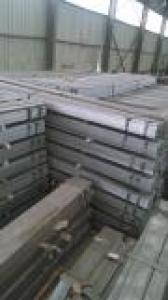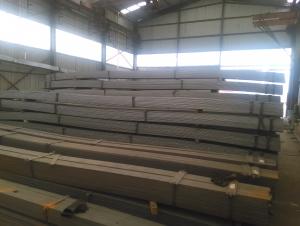Steel Flat Bar Q235 Hot Rolled Black Mild Steel Flat Bar
- Loading Port:
- Tianjin
- Payment Terms:
- TT or LC
- Min Order Qty:
- 30 m.t.
- Supply Capability:
- 40000 m.t./month
OKorder Service Pledge
OKorder Financial Service
You Might Also Like
Product Description:
OKorder is offering Steel Flat Bar Q235 Hot Rolled Black Mild Steel Flat Bar at great prices with worldwide shipping. Our supplier is a world-class manufacturer of steel, with our products utilized the world over. OKorder annually supplies products to European, North American and Asian markets. We provide quotations within 24 hours of receiving an inquiry and guarantee competitive prices.
Product Applications:
Steel Flat Bar Q235 Hot Rolled Black Mild Steel Flat Bar are ideal for structural applications and are widely used in the construction of buildings and bridges, and the manufacturing, petrochemical, and transportation industries.
Product Advantages:
OKorder's Steel Flat Bar Q235 Hot Rolled Black Mild Steel Flat Bar are durable, strong, and resist corrosion.
Main Product Features:
· Premium quality
· Prompt delivery & seaworthy packing (30 days after receiving deposit)
· Corrosion resistance
· Can be recycled and reused
· Mill test certification
· Professional Service
· Competitive pricing
Product Specifications:
| Name | carbon hot rolled black mild steel flat bar |
| Standard | AISI, ASTM, BS,DIN,GB,JIS |
| Grade | A36, SS400, Q235, Q345, S235,S275 |
| Dimensions | 1.5mm-14mm |
| Length | 6-12m |
| Technique | carbon hot rolled black mild steel flat bar |
| Tolerance | As the standard or as your requirement |
| Application | Metal structure, bridge, machiner, shipbuilding industry |
| Certificated | BV carbon hot rolled black mild steel flat bar |
| MOQ | 25 tons |
| Delivery | Within 25 days after deposit |
| Payment | T/T or L/C |
FAQ:
Q1: Why buy Materials & Equipment from OKorder.com?
A1: All products offered byOKorder.com are carefully selected from China's most reliable manufacturing enterprises. Through its ISO certifications, OKorder.com adheres to the highest standards and a commitment to supply chain safety and customer satisfaction.
Q2: How do we guarantee the quality of our products?
A2: We have established an advanced quality management system which conducts strict quality tests at every step, from raw materials to the final product. At the same time, we provide extensive follow-up service assurances as required.
Q3: How soon can we receive the product after purchase?
A3: Within three days of placing an order, we will begin production. The specific shipping date is dependent upon international and government factors, but is typically 7 to 10 workdays.
Images:
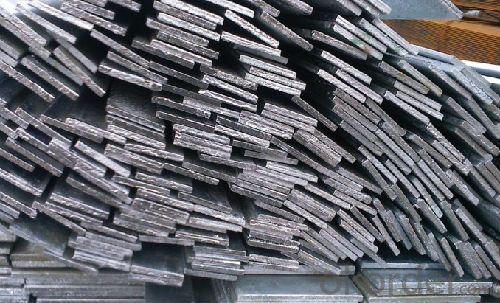

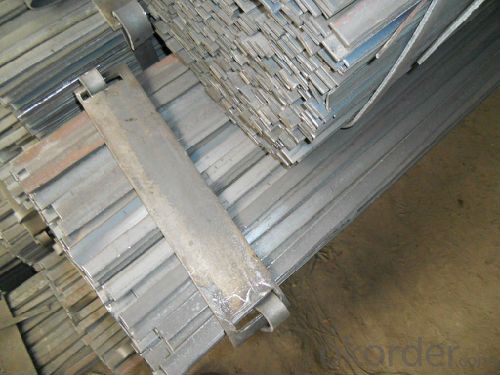
- Q:Can steel flat bars be used for making brackets or supports for telecommunications towers?
- Yes, steel flat bars can be used for making brackets or supports for telecommunications towers. Steel is commonly used in the construction of telecommunications towers due to its strength, durability, and ability to withstand harsh weather conditions. Steel flat bars can be easily fabricated and customized to meet the specific requirements of the tower, providing reliable support and stability.
- Q:Can steel flat bars be used for electrical or grounding applications?
- Steel flat bars are not usually employed for electrical or grounding purposes. This is due to steel's conductivity and potential safety hazards associated with its use in such applications. Instead, materials such as copper or aluminum are commonly utilized. These materials possess outstanding electrical conductivity and low resistance, making them ideal for handling high currents and facilitating efficient electrical conductivity. Moreover, they are capable of dissipating any excessive heat generated during operation. Consequently, it is advisable to opt for materials explicitly designed for electrical or grounding applications, rather than steel flat bars.
- Q:What is the typical bend radius for steel flat bars?
- The bend radius of steel flat bars can vary depending on factors such as thickness, width, and the grade of steel employed. However, a common rule of thumb dictates that the minimum bend radius for steel flat bars is typically around three times the thickness of the bar. For instance, if the flat bar measures 1/4 inch in thickness, the minimum bend radius would be approximately 3/4 inch. It is crucial to bear in mind that these are merely general guidelines, and the specific bend radius should be determined by taking into account variables such as the desired bend angle, the equipment used, and any project-specific requirements or standards.
- Q:Are steel flat bars suitable for fabrication of frames or structures?
- Yes, steel flat bars are suitable for the fabrication of frames or structures. Steel is a strong and durable material, and flat bars provide stability and support for various applications. They are commonly used in construction, manufacturing, and engineering projects. Steel flat bars offer excellent load-bearing capacity, resistance to bending and warping, and can be easily welded or bolted together to create frames and structures of various sizes and shapes. Additionally, steel flat bars are cost-effective and readily available in different grades and sizes, making them a versatile choice for fabricating frames or structures.
- Q:What is the appearance of hot galvanizing and cold galvanized flat steel?
- The appearance of cold plating smooth point heat plating, there is also the difference between the two prices, if the project budget it is recommended to use a hot dip, if it is hot for outdoor plating relatively easy to rust, cold plating used in outdoor it is easy to rust, the appearance is not good, relatively Engineering the quality will also be questioned, if you can use the indoor cold plating, can save a lot of budget
- Q:Can steel flat bars be used for reinforcing concrete structures?
- Yes, steel flat bars can be used for reinforcing concrete structures. They provide additional strength and support to the concrete, enhancing its structural integrity and resistance to tension forces. Flat bars are commonly used as reinforcement in beams, columns, slabs, and other concrete elements to prevent cracking and increase overall durability.
- Q:What are the different methods of joining steel flat bars together?
- There are several methods of joining steel flat bars together, each with its own advantages and disadvantages. Here are some of the most common methods: 1. Welding: Welding is the most common method of joining steel flat bars together. It involves melting the edges of the bars and fusing them together using heat. This creates a strong and permanent bond. There are different types of welding techniques, such as arc welding, MIG welding, and TIG welding, which can be used depending on the specific requirements of the project. 2. Bolting: Bolting is another method used to join steel flat bars together. It involves drilling holes in the bars and then using bolts, nuts, and washers to secure them. This method allows for easy disassembly and reassembly, making it suitable for applications that require frequent maintenance or adjustments. 3. Riveting: Riveting involves inserting a rivet, a metal pin or bolt, through holes drilled in the bars and then deforming the end to create a head, securing the bars together. This method provides a strong and durable connection and is commonly used in structural applications. 4. Adhesive bonding: Adhesive bonding involves using a suitable adhesive or epoxy to bond the steel flat bars together. This method is commonly used when welding or bolting is not feasible or desired. Adhesive bonding can provide a strong and corrosion-resistant joint, but it may not be as structurally strong as other methods. 5. Clamping: Clamping is a temporary method used to hold steel flat bars together. It involves using clamps or vices to apply pressure and hold the bars in place. This method is often used during the welding or adhesive bonding process to ensure a tight fit and prevent movement. It is important to consider the specific requirements of the project, such as strength, durability, disassembly needs, and aesthetic appearance, when choosing the appropriate method to join steel flat bars together.
- Q:What are the different methods of joining steel flat bars?
- There exist multiple techniques for connecting steel flat bars, each having distinct advantages and constraints. 1. The most typical approach is welding. This involves fusing the edges of the bars together, which then cool and solidify to form a robust bond. Welding offers versatility, with options like arc welding, gas welding, or spot welding. 2. Bolting is another well-liked method. It entails drilling holes in the bars and securing them with bolts and nuts. Bolting allows for easy disassembly and reassembly, making it suitable for temporary connections or situations requiring frequent maintenance. 3. Riveting involves using metal fasteners called rivets to join the bars. A hole is drilled through the bars, and a rivet is inserted and secured by hammering or mechanical pressing. Riveting provides a strong and permanent connection, but it demands specialized tools and skills. 4. Adhesive bonding is a method employing industrial adhesives to connect steel flat bars. The adhesive is applied to the surfaces, and pressure is applied to achieve a robust bond. Adhesive bonding can be a viable alternative when welding is unsuitable or when a more visually appealing joint is desired. However, its bond strength may be lower compared to welding or mechanical fastening methods. 5. Mechanical fasteners, such as screws, nails, or clips, can also be used to join steel flat bars. These fasteners are inserted into pre-drilled holes or slots in the bars and tightened to secure the connection. While mechanical fasteners offer quick assembly and disassembly, their strength may not match that of welding or riveting. When choosing the appropriate method for joining steel flat bars, it is crucial to consider factors like the intended use, load-bearing requirements, aesthetics, and ease of assembly. Each method has its own advantages and constraints, and the best choice will depend on the specific application.
- Q:How do you store steel flat bars to prevent damage?
- To ensure the steel flat bars are stored properly and protected from damage, there are several important steps to consider: 1. Select a suitable storage area: It is crucial to choose a clean, dry, and well-ventilated space for storage. Avoid areas with high moisture levels or extreme temperature changes. If possible, designate a specific area exclusively for storing steel flat bars to minimize the chances of damage. 2. Use proper stacking methods: When stacking multiple steel flat bars, place them horizontally on a flat surface. Make sure they are aligned properly and parallel to each other. Avoid stacking them too high to prevent excessive weight that could cause bending or warping. 3. Employ suitable supports: Insert timber or rubber supports between each layer of stacked flat bars. These supports will prevent direct contact between the bars, reducing the risk of scratches or surface damage. They also help distribute weight evenly and maintain the flatness of the bars. 4. Protect against moisture: Moisture can lead to rust or corrosion on steel flat bars. To prevent this, consider using moisture-absorbing materials like silica gel packets or desiccants in the storage area. Additionally, cover the stacked bars with a plastic sheet or tarp to shield them from moisture and humidity. 5. Maintain an organized inventory: Keep a thorough record of the stored steel flat bars, including their dimensions, grades, and quantities. Regularly inspect the inventory to identify any signs of damage, rust, or deformation. This will allow you to address any issues promptly and prevent further damage. 6. Take precautions during handling and transportation: When moving or transporting steel flat bars, use appropriate lifting equipment such as forklifts or cranes to avoid putting excessive stress on the bars. Always handle them with care and avoid dropping or dragging them, as these actions can result in dents, scratches, or deformation. By following these guidelines, you can ensure the proper storage of steel flat bars and minimize the risk of damage, thus preserving their quality and integrity.
- Q:How do you determine the load capacity of a steel flat bar?
- To determine the load capacity of a steel flat bar, you need to consider factors such as the dimensions and material properties of the bar, the type of loading it will experience, and the desired safety factor. Calculations involving formulas and engineering principles can be used to determine the maximum load the flat bar can withstand without experiencing permanent deformation or failure.
1. Manufacturer Overview |
|
|---|---|
| Location | |
| Year Established | |
| Annual Output Value | |
| Main Markets | |
| Company Certifications | |
2. Manufacturer Certificates |
|
|---|---|
| a) Certification Name | |
| Range | |
| Reference | |
| Validity Period | |
3. Manufacturer Capability |
|
|---|---|
| a)Trade Capacity | |
| Nearest Port | |
| Export Percentage | |
| No.of Employees in Trade Department | |
| Language Spoken: | |
| b)Factory Information | |
| Factory Size: | |
| No. of Production Lines | |
| Contract Manufacturing | |
| Product Price Range | |
Send your message to us
Steel Flat Bar Q235 Hot Rolled Black Mild Steel Flat Bar
- Loading Port:
- Tianjin
- Payment Terms:
- TT or LC
- Min Order Qty:
- 30 m.t.
- Supply Capability:
- 40000 m.t./month
OKorder Service Pledge
OKorder Financial Service
Similar products
New products
Hot products
Related keywords
